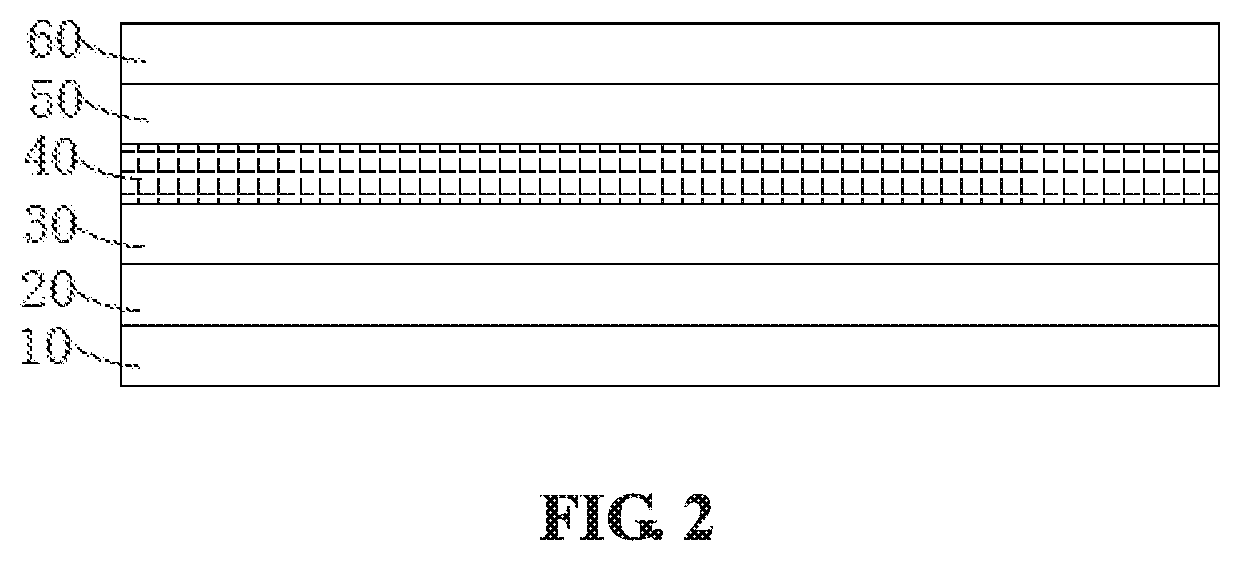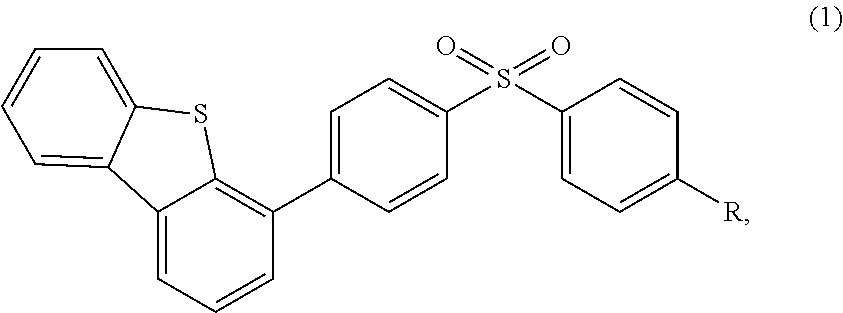Organic monomolecular white light material, manufacturing method for the same, and OLED element
a monomolecular white light material and manufacturing method technology, applied in the field of display technology, can solve the problems of poor luminescent stability, easy phase separation, complex preparation process, etc., and achieve the effect of high efficiency and stabl
- Summary
- Abstract
- Description
- Claims
- Application Information
AI Technical Summary
Benefits of technology
Problems solved by technology
Method used
Image
Examples
embodiment 1
s of 4-(4-(benzenesulfonyl)phenyl)dibenzothiophene
[0057](1) a first intermediate (i.e., 1-bromo-4-(benzenesulfonyl)benzene) is synthesized, and the synthetic route thereof is shown as the following equation (2):
[0058]
[0059]Benzenesulfonyl chloride (1.00 g, 5.68 mmol) and bromobenzene (1.33 g, 8.52 mmol) are added in 250 mL of a three necked flask, and are dissolved with 20 mL of dichloromethane. Then, after ferric chloride (1.83 g, 11.37 mmol) is added, the reaction mixture is heated to 40° C., and is stirred to react for 6 hours. Then, the reaction mixture is cooled to room temperature, and then 20 mL dichloromethane and 20 mL 1M diluted hydrochloric acid are slowly added, and are stirred for 10 minutes. Then, the mixed solution is poured in a separating funnel, and then the organic layer solution thereof is separated and stored. Also, the water layer solution thereof is extracted three times with dichloromethane, and then is combined in the organic layer solution. Then, the organi...
embodiment 2
s of 4-((4-(dibenzothiophene-4-yl)phenyl)sulfonyl)-N,N-diphenylamine
[0063](1) a second intermediate (i.e., 1-(4-fluorobenzenesulfonyl)-4-bromobenzene) is synthesized, and the synthetic route thereof is shown as the following equation (4):
[0064]
[0065]4-bromobenzenesulfonyl chloride (5.00 g, 19.69 mmol) and fluorobenzene (2.84 g, 29.54 mmol) are added in 250 mL of a three necked flask, and are dissolved with 40 mL of dichloromethane. Then, after ferric chloride (6.34 g, 39.39 mmol) is added, the reaction mixture is heated to 40° C., and is stirred to react for 6 hours. Then, the reaction mixture is cooled to room temperature, and then 30 mL dichloromethane and 50 mL 1M diluted hydrochloric acid are slowly added, and are stirred for 10 minutes. Then, the mixed solution is poured in a separating funnel, and then the organic layer solution thereof is separated and stored. Also, the water layer solution thereof is extracted three times with dichloromethane, and then is combined in the org...
embodiment 3
s of 9-(4-((4-(dibenzothiophene-4-yl)phenyl)sulfonyl)phenyl)-9H-carbazole
[0072](1) a target product (i.e., 9-(4-((4-(dibenzothiophene-4-yl)phenyl)sulfonyl)phenyl)-9H-carbazole) is synthesized, and the synthetic route thereof is shown as the following equation (7):
[0073]
[0074]Carbazole (0.48 g, 2.87 mmol) is added in a three necked flask, and then 15 mL N,N-dimethylformamide (DMF) and potassium tert-butoxide (0.64 g, 5.74 mmol) are added successively, and are stirred for 20 minutes after argon is passed through therein. Then, after the third intermediate (0.80 g, 1.91 mmol) is added, the reaction mixture is heated to 110° C., and is reacted for 6 hours. Then, the reaction mixture is cooled to room temperature, and is added in 200 mL saturated salt water to separate out solids, and then is filtrated. Then, the crude product thereof is separated and purified by a silica gel column with an eluent, which is the mixed solution of n-hexane and dichloromethane (volume ratio of 1:1). Then, t...
PUM
| Property | Measurement | Unit |
|---|---|---|
| quantum efficiency | aaaaa | aaaaa |
| quantum efficiency | aaaaa | aaaaa |
| quantum efficiency | aaaaa | aaaaa |
Abstract
Description
Claims
Application Information
 Login to View More
Login to View More - R&D
- Intellectual Property
- Life Sciences
- Materials
- Tech Scout
- Unparalleled Data Quality
- Higher Quality Content
- 60% Fewer Hallucinations
Browse by: Latest US Patents, China's latest patents, Technical Efficacy Thesaurus, Application Domain, Technology Topic, Popular Technical Reports.
© 2025 PatSnap. All rights reserved.Legal|Privacy policy|Modern Slavery Act Transparency Statement|Sitemap|About US| Contact US: help@patsnap.com



